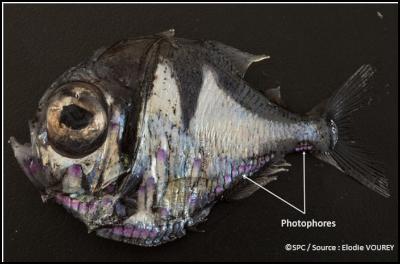New Fish Species Discovered in the Waters of New Caledonia
New Fish Species Discovered in the Waters of New Caledonia

Tuesday, 2 September 2014, the Secretariat of the Pacific Community (SPC), Noumea, New Caledonia
While on a boat not far from Toombo Reef near Boulari Pass on 11 August 2014, Pierre and William Larue found a small silvery fish floating on the water. The fish was first given to the IRD (French Institute of Research for Development) and then SPC took over the task of identifying this small hatchetfish from the Sternoptychidae family.
Fish from this family are micronekton, i.e. marine organisms that measure from 2 to 20 cm in length. They feed on small fish, crustaceans and molluscs and mainly live at depths of 200 to 2000 m. That is why it is extremely rare to see such specimens at the surface of the water. According to the fishers’ remarks, it seems that a school of dolphins was at the site; it is possible that as the dolphins were coming up from the deepwater, they pushed the fish to the surface.
This fish family has photophores (light-emitting organs) on their bodies, whose characteristics are important for identifying the species. Adult fish can grow to lengths of 7 cm and are part of the diet of big-eyed tuna.
After an in-depth study of the fish’s shape and colour and the location of its photophores, Elodie Vourey, a specialist in marine species identification at the SPC laboratory, concluded that this fish was from a species of the Polyipnus genus that had never been seen in the world before. This discovery was confirmed by an American hatchetfish specialist and the researchers at the French National Museum of Natural History were also contacted about conserving the specimen in the museum’s collection.
Other specimens need to be recovered because with just one it is not possible to publish a description of this new species or give it a name. In collaboration with IRD, the SPC team hopes to be able to find other specimens of the fish during the upcoming NECTALIS-3 mission, which will explore the waters offshore the southern part of New Caledonia in order to better understand the workings of the deep-sea ecosystem where tuna live. During this three-week mission, scientists will collect physical data on temperatures, currents, etc.; chemical data on nitrates, phosphates, and other substances; and biological data on phytoplankton, zooplankton and the fish, squid and crustaceans that make up the micronekton.
This discovery once again demonstrates that there is still much to learn about our marine environment and that many biodiversity treasures are waiting to be found in our waters.
ENDS


 Carbon Market Watch: Going For Green - Is The Paris Olympics Winning The Race Against The Climate Clock?
Carbon Market Watch: Going For Green - Is The Paris Olympics Winning The Race Against The Climate Clock? New Zealand Defence Force: NZDF Working With Pacific Neighbours To Support Solomon Islands Election
New Zealand Defence Force: NZDF Working With Pacific Neighbours To Support Solomon Islands Election UN News: Ceasefire The Only Way To End Killing And Injuring Of Children In Gaza
UN News: Ceasefire The Only Way To End Killing And Injuring Of Children In Gaza ICHRP: US-Japan-Philippines Trilateral Summit Makes The Philippines A Battlefield For US-China Conflict
ICHRP: US-Japan-Philippines Trilateral Summit Makes The Philippines A Battlefield For US-China Conflict East West Center: Environmental Journalist Alexander Kaufman Receives East-West Center’s Inaugural Melvin M.S. Goo Writing Fellowship
East West Center: Environmental Journalist Alexander Kaufman Receives East-West Center’s Inaugural Melvin M.S. Goo Writing Fellowship Compassion in World Farming: Octopus Farm Must Be Stopped, Say Campaigners
Compassion in World Farming: Octopus Farm Must Be Stopped, Say Campaigners